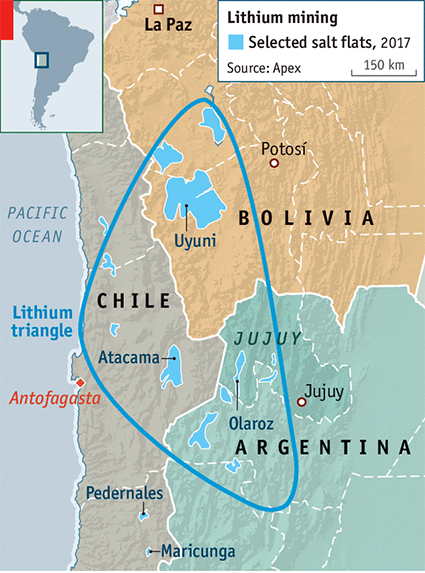Adverse Effects of Lithium Mining | 02 Sep 2024
Why in News?
According to a new study, land subsidence is occurring in Chile's Atacama salt flat due to lithium mining.
What are the Key Revelations of the Study?
- Findings:
- Rate of Sinking: The Atacama salt flat in Chile is sinking at a rate of 1 to 2 centimetres per year due to lithium brine extraction.
- Lithium Mining Impact on the Environment:
- Water Usage: The process requires massive amounts of fresh water, with 2,000 tons of water needed to produce one ton of lithium.
- Water Scarcity: This extraction exacerbates water scarcity in the Atacama Desert, affecting both local communities and ecosystems.
- Chemical Contamination: Chemicals like sulfuric acid and sodium hydroxide used in lithium extraction contaminate soil and water, harming ecosystems and endangering species.
- Impact on Wildlife: A 2022 study highlighted a decline in flamingo populations in the Atacama region due to reduced water levels, which affect their reproduction rates.
- Potential Impact of Lithium Mining in Reasi (J&K):
- Water Crisis: Many villages in Reasi are struggling to access enough water, after perennial streams dried up following the construction of the Chenab Rail Bridge.
- Water-intensive lithium mining can further worsen the situation.
- Threat to Biodiversity: The Himalayan region in J&K is a biodiversity hotspot and a eco-sensitive region, and mining could lead to a significant loss of biodiversity.
- It can hamper the habitat of migratory birds like Common Teal, Northern Pintail etc who come every year to stay in lakes, marshes and wetlands of Jammu and Kashmir.
- Food Insecurity: Mining and processing lithium can further jeopardise food security through its excessive carbon emissions, water, and land use methods.
- Pollution: The Himalayas are the source of so many rivers and mining activity may pollute the entire riparian ecosystem.
- Water Crisis: Many villages in Reasi are struggling to access enough water, after perennial streams dried up following the construction of the Chenab Rail Bridge.
What are the Key Facts about Lithium?
- About: It is a soft, silvery metal. It has the lowest density of all metals.
- It has high reactivity, low density and excellent electrochemical properties.
- Its ores are Petalite, Lepidolite and Spodumene. It is also known as the “white gold”.
- Applications:
- Batteries: The most important use of lithium is in rechargeable batteries for mobile phones, laptops, digital cameras and electric vehicles.
- Lithium is also used in some non-rechargeable batteries for things like heart pacemakers, toys and clocks.
- Alloys: A magnesium-lithium alloy is used for armour plating.
- Air Conditioning: Lithium chloride and lithium bromide are used in air conditioning and industrial drying systems due to their hygroscopic properties.
- Lubricants: Lithium stearate is used as an all-purpose and high-temperature lubricant.
- Batteries: The most important use of lithium is in rechargeable batteries for mobile phones, laptops, digital cameras and electric vehicles.
- Reserves: Chile holds the largest lithium reserves globally, accounting for 36% of the total, and is the second-largest producer, contributing 32% to the world's supply.
- Chile is a part of the "lithium triangle" along with Argentina and Bolivia.
- Australia and China are the first and third largest producers of Lithium globally.
Atacama Desert
- Location: The Atacama Desert is located in Chile between the Cordillera de la Costa mountain range and the Andes Mountains.
- Climate: The desert is shielded from rainfall by the Andes Mountains to the east and experiences atmospheric conditions that prevent cloud formation due to cold water upwelling (Peru/Humboldt Current) from the Pacific Ocean.
- Temperatures: Unlike other deserts, the Atacama has a mild average temperature of about 18 degrees Celsius due to the temperate climate and upwelling of cold water.
- Mineral Resources:
- Salt Deposits: The desert's core is covered in thick salt deposits called playas.
- Nitrate Belt: The desert contains nitrate minerals, historically mined for use in explosives and fertilisers.
- Mineral Richness: It is rich in other materials like lithium, copper, and iodine.
- Protected Areas: Pan de Azúcar National Park is the only large national protected area within the ecoregion.
Read More: India's Lithium Mining Challenges
|
Drishti Mains Question: Q. Discuss the adverse environmental impacts of lithium mining. How does it pose a threat to the eco-sensitive regions of the country? |
UPSC Civil Services Examination, Previous Year Questions (PYQs)
Prelims
Q. Which one of the following pairs of metals constitutes the lightest metal and the heaviest metal, respectively? (2008)
(a) Lithium and mercury
(b) Lithium and osmium
(c) Aluminium and osmium
(d) Aluminium and mercury
Ans: (b)
Q. What could be the main reason/reasons for the formation of African and Eurasian desert belt? (2011)
- It is located in the sub-tropical high pressure cells.
- It is under the influence of warm ocean currents.
Which of the statements given above is/are correct in this context?
(a) 1 only
(b) 2 only
(c) Both 1 and 2
(d) Neither 1 nor 2
Ans: (a)
Mains
Q. Coastal sand mining, whether legal or illegal, poses one of the biggest threats to our environment. Analyse the impact of sand mining along the Indian coasts, citing specific examples. (2019)
Q. What are the impediments in disposing of the huge quantities of discarded solid waste which are continuously being generated? How do we safely remove the toxic wastes that have been accumulating in our habitable environment? (2018)


